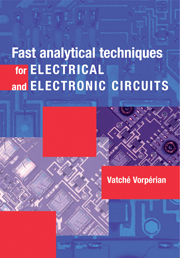5 - Electronic negative feedback
Published online by Cambridge University Press: 12 January 2010
Summary
Introduction
Perhaps the best introductory remarks on electronic negative feedback are given by Harold S. Black in his patent application on the Wave Translation System, assigned to Bell Telephone Laboratories on December 21, 1937. In this patent application not only do we learn how the inventor set out to solve all the major problems that plagued open-loop amplifiers at one fell swoop, but we also learn that negative and positive feedback were in fact employed prior to his invention to (a) build oscillators and regenerative feedback amplifiers and (b) prevent open-loop amplifiers, with parasitic positive feedback, from oscillating. Designers at the time knew quite well how to build an oscillator starting with an amplifier with a large gain A and feeding back a portion of the output in phase with the input, with a magnitude larger than the input. They also realized they could obtain very large gains from a single-stage amplifier by feeding back its output in phase with the input but with a magnitude less than the input signal – a technique known as regenerative feedback. As far as negative feedback was concerned, it was applied only in small amounts to prevent an amplifier from “singing”, or oscillating, by countering the amount of positive feedback due to parasitic coupling between its input and output.
What Black discovered was that if negative feedback was applied in larger amounts than previously attempted, the closed-loop gain became independent of the gain A of the open-loop amplifier and depended only on the reciprocal of the gain of the feedback network, 1/β, as long as the product of both gains was considerably larger than unity, i.e. Aβ »1.
Information
- Type
- Chapter
- Information
- Publisher: Cambridge University PressPrint publication year: 2002
